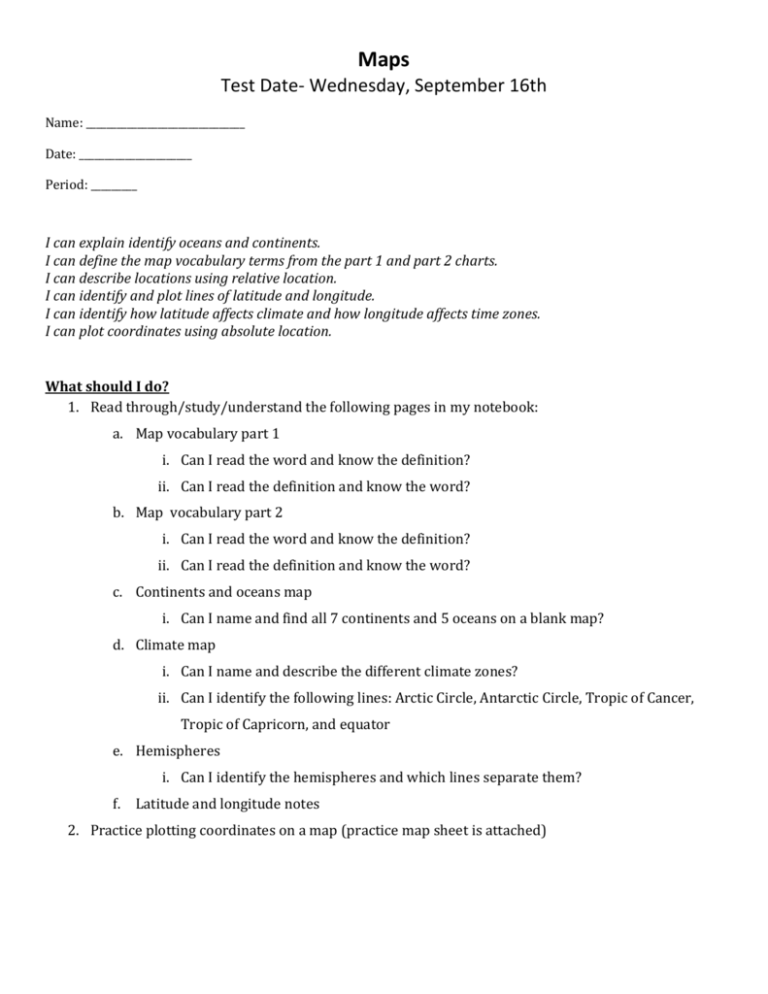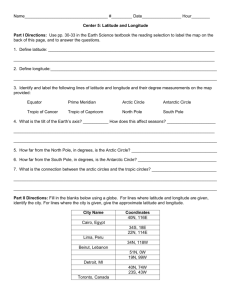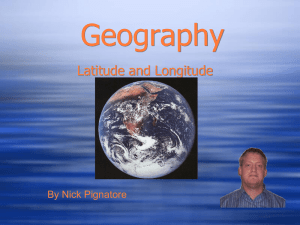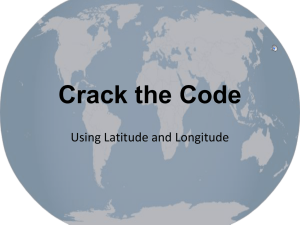Study Guide - Mayfield City School District
advertisement

Maps Test Date- Wednesday, September 16th Name: _______________________________ Date: ______________________ Period: _________ I can explain identify oceans and continents. I can define the map vocabulary terms from the part 1 and part 2 charts. I can describe locations using relative location. I can identify and plot lines of latitude and longitude. I can identify how latitude affects climate and how longitude affects time zones. I can plot coordinates using absolute location. What should I do? 1. Read through/study/understand the following pages in my notebook: a. Map vocabulary part 1 i. Can I read the word and know the definition? ii. Can I read the definition and know the word? b. Map vocabulary part 2 i. Can I read the word and know the definition? ii. Can I read the definition and know the word? c. Continents and oceans map i. Can I name and find all 7 continents and 5 oceans on a blank map? d. Climate map i. Can I name and describe the different climate zones? ii. Can I identify the following lines: Arctic Circle, Antarctic Circle, Tropic of Cancer, Tropic of Capricorn, and equator e. Hemispheres i. Can I identify the hemispheres and which lines separate them? f. Latitude and longitude notes 2. Practice plotting coordinates on a map (practice map sheet is attached) Types of Maps Match the type of map to its definition. 1. __________ shows boundaries and locations of countries, states, and major cities 2. __________the natural resources in an area and the products made in that area 3. __________shows the average monthly or yearly weather conditions 4. __________amount of people that live in an area relative to the space occupied by them 5. __________type of physical map that shows elevation (how high a place is above sea level 6. ___________shows the geographic features of an area (seas, islands, mountains, lakes, rivers, deserts) Label the 7 continents and 5 oceans A. Physical B. Political C. Climate D. Population Density E. Product F. Topographical Vocabulary Fill in the blanks with the correct vocabulary word. 1. Lines of ______________________________ run east and west but measure north and south. 2. Lines of _______________________________ run north and south but measure east and west. 3. The most important line of latitude is the _________________________ which measures 0 degrees. 4. The most important line of longitude is the _______________________________ which measures 0 degrees. 5. _________________________ is weather in a place over a long period of time. 6. _________________________ is another name for lines of longitude. 7. _________________________ is another name for lines of latitude. 8. _________________________________ is a name for the supercontinent that existed millions of years ago. 9. A ________________________ explains what each symbol represents on a map. 10. A __________________________shows how much a map has been reduced from the area it represents. It tells what each distance on the map represents in real life. 11. A ___________________________ shows where each of the cardinal directions are. 12. Someone who makes maps is called a ________________________________. 13. When you give a location in relation to another place you are using _______________________ location. 14. Giving a location based on coordinates is using _____________________________ location. 15. The top boundary of the tropic region is known as the __________________________________________ and measures 23.5 degrees North. 16. The bottom boundary of the tropic region is known as the ________________________________________and measures 23.5 degrees South. 17. The region above the 66 degree North line is known as the _______________________________________. 18. The region below the 66 degree South line is known as the _______________________________________. 19. There are 24 ____________________________ for each hour of the day. They run with the lines of longitude. 20. The _________________________________________ establishes where days begin and measures 180 degrees. Longitude and Latitude Lines Fill in the chart using the words below – are the terms latitude or longitude? Equator lines measure north and south Tropic of Cancer International Date Line Tropic of Capricorn Arctic Circle Time zones Lines measure east and west Antarctic Circle Maximum is 90° Maximum is 180° Climate Lines run north and south lines run east and west Prime Meridian Latitude Longitude Plotting Practice Plot the following points on the map: A.) 40° S, 60° W B.) 60°N, 100°E C.) 80°N, 30°W D.) 0°, 20°E E.) 0°, 0° F.) 30°N, 40°E G.) 51°S, 65°E H.) 15°N, 80°W I.) 42°N, 143°E J.) 57°S, 74°E










